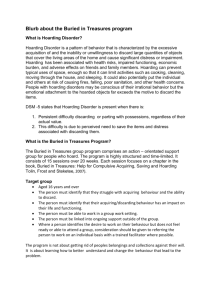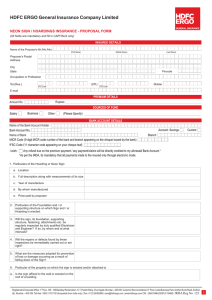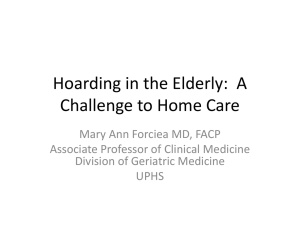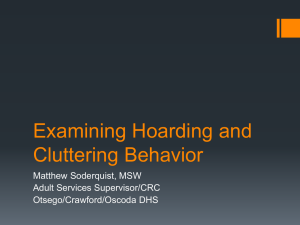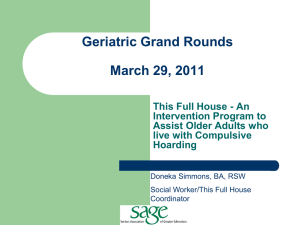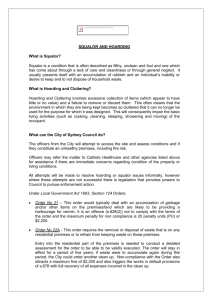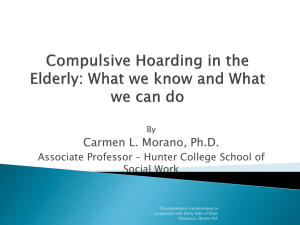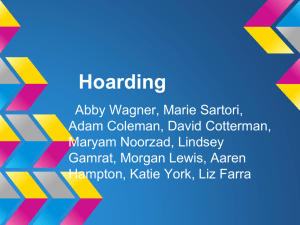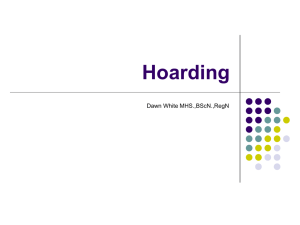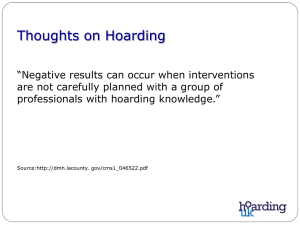A wicked problem - Age Concern Canterbury
advertisement
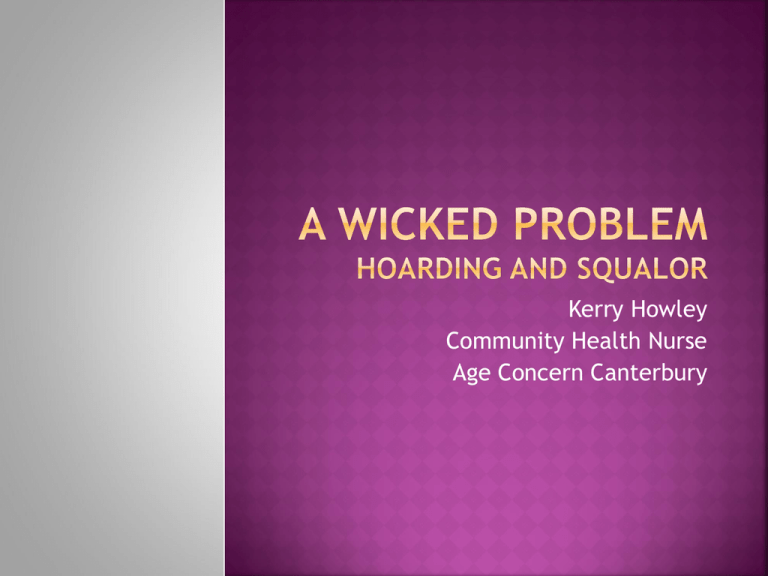
Kerry Howley Community Health Nurse Age Concern Canterbury Difficult to clearly define Many interdependencies and multi-causal Problems may be unstable and continue evolving Problems are socially complex and many stakeholders No clear or correct solution Responsibility stretches across many organisations Proposed measures may have unforeseen effects The accumulation of and failure to discard a large number of objects that seem to be useless or of limited value Extensive clutter in living spaces that prevents the effective use of the spaces, and Significant distress or impairment caused by hoarding Squalor may be present in hoarding homes There can be squalor without hoarding Squalor may result from rotting food, animal or human waste, insect infestation or vermin Offensive odours Home maintenance poor – plumbing, wiring, structure of the home, roof etc Health risk to occupant(s) and visitors to the home Deprivation Grief and loss – Post Traumatic Stress Disorder Learned behaviour Mental health Major Depressive Disorder >50% ADD 30% and Hyperactivity 15% Anxiety 30% OCD 17% Social Phobia 30% Dementia – reduced cognitive ability Addictive personality – ETOH, collecting Diagnostic and Statistical Manual of Mental Disorders due out in May 2013? OCD classification currently Move to a separate classification in DSM-5 Hoarding Disorder Is living in clutter a lifestyle choice? Reclusive Socially awkward and isolated Embarrassed and/or ashamed Fear of authorities Resistant to enforced change Wanting help with the problem Wanting non-judgemental support Falls, trips and injuries Becoming trapped by “stuff” Mould and mildew Respiratory problems Poor food hygiene and personal hygiene Increased risk of infection, contamination Animals – diseases, excrement and urine Vermin – rats, mice Insects – fleas, cockroaches, flies, ants etc. Fire risk Increased risk of fatality Increased response needed from fire service Increased risk to emergency services if called to property Increased risk to neighbours Can occur in hoarding environments Person prioritises animals over themselves Middle aged or older and 75% women Denial and minimisation of problems Unsanitary conditions due to animals Often identified following complaints from neighbours Public expectations of SPCA Animal welfare is their primary concern We don’t really know how many cases there are As statistics not collected No single point of entry Cases with multiple agencies Little sharing or collaboration between agencies Anecdotally more cases since the earthquakes Possible increase with ageing population Possible increase with decrease in domestic assistance There is always a cost to helping the hoarder Support worker Rubbish disposal and/or skip hire Structural repairs to the home Treatment for the person Garden maintenance and removal of green waste Clients ability to pay The challenge of finding money Practitioner time spent finding funding Each practitioner working as individual What is the landlords responsibility? Currently slow response Confusion as to who is responsible/lead worker Earlier intervention better Assessment tools Team approach needed Need skilled workers, GP, psychologist, social workers etc. Ongoing training and support for staff working in this area Clutter Image Rating Scale (CIR) http://stoppests.typepad.com/files/clutter-image-rating-scale-1.pdf Activities http://www.cornellaging.org/gem/pdf/assessment_tool.pdf Hoarding of Daily Living – Hoarding (ADL-H) Rating Scale http://www.ocfoundation.org/uploadedFiles/Hoarding/Resources/Hoardi ng%20Rating%20Scale%20with%20interpret.pdf Important so that all practitioners and team are talking the same language Preferably implemented nationally Bring together a small group of interested people to coordinate management of cases Modify assessment tools to suit NZ conditions Develop a factsheet for general distribution Single point of entry Identify funding sources Gather statistics Measure outcomes and successes Professional development and supervision for people working with hoarding and squalor App for Android or iPhones Squalor and Hoarding Toolkit http://squalorandhoarding.catholiccommunit yservices.com.au/ Working with People with Hoarding Behaviours (DVD) Stuff Happens (Audio CD) Catholic Community Services – enquiries 1800 225 474 The Hoarding Handbook ISBN 978-0-19-538551-9 Most hoarders have a mental health condition which can be treated Most people want help Treat client with respect How to decide when to intervene Plan assessment and treatment Involve other help and agencies Information sharing to support people
